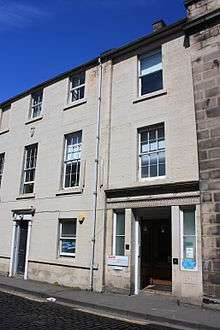Arthur Perigal
Arthur Perigal (1784?–19 September xx1847) was an English historical, portrait and landscape painter.

Life
Perigal was born about 1784. He studied under Henry Fuseli at the Royal Academy, and in 1811 gained the gold medal for historical painting, the subject being Themistocles taking Refuge at the Court of Admetus.[1]
Perigal for some time practised portrait-painting in London; but about 1820 he appears to have gone to Northampton, and then moved to Manchester. He settled in Edinburgh, where he taught drawing, and from 1833 onwards exhibited portraits and landscapes at the Royal Scottish Academy.[1]
In the 1830s Perigal is listed as living at 6 St Vincent Street in the Stockbridge area of Edinburgh.[2]
Perigal died at 21 Hill Street, Edinburgh, on 19 September 1847, aged 63.[1]
He is buried in Dean Cemetery near the north-west corner of the original cemetery.
Works
Perigal began in 1810 to exhibit at the Royal Academy and the British Institution, sending the former a portrait and Queen Katherine delivering to Capucius her Farewell Letter to King Henry the Eighth, and to the latter The Restoration of the Daughters of Œdipus and Helena and Hermia (from Midsummer Night's Dream). These works were followed at the Royal Academy by Aridæus and Eurydice in 1811, his Themistocles in 1812, The Mother's last Embrace of her Infant Moses in 1813, and again in 1816; his last picture at the Academy was Going to Market, appeared in 1821. His contributions to the British Institution included Roderick Dhu discovering himself to FitzJames in 1811, the Death of Rizzio in 1813, Joseph sold by his Brethren in 1814, Scipio restoring the Captive Princess to her Lover in 1815, and, lastly, The Bard in 1828.[1]
Family
His son, Arthur Perigal, the younger (1816–1884) was a landscape-painter.[1]
Notes
- Lee, Sidney, ed. (1896). . Dictionary of National Biography. 45. London: Smith, Elder & Co.
- "Edinburgh Post Office annual directory, 1832-1833". National Library of Scotland. Retrieved 18 January 2018.
- Attribution
![]()